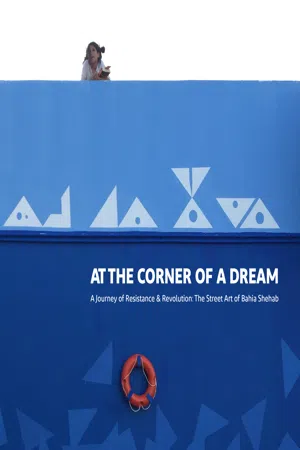
eBook - ePub
At the Corner of a Dream: A Journey of Resistance and Revolution
The Street Art of Bahia Shehab
- English
- ePUB (mobile friendly)
- Available on iOS & Android
eBook - ePub
At the Corner of a Dream: A Journey of Resistance and Revolution
The Street Art of Bahia Shehab
About this book
Working with stylized typographic and calligraphic forms, Egyptian-Lebanese street artist Bahia Shehab brings creative presentations of language and culture to public spaces around the world. During the Egyptian revolution of 2011, she began taking to the streets to paint. Starting in Cairo, Shehab began creating large-scale public art as a form of resistance against military rule and violence. With her spray can in hand, this artist, designer, and historian set out to spread beautiful and empowering images in the face of tumultuous times. Now she has taken her peaceful resistance to the streets of the world, creating works in cities from New York to Tokyo, Amsterdam, and Honolulu. Engaging with identity and the preservation of cultural heritage, Shehab creates work that investigates Islamic art history and reinterprets contemporary Arab politics, feminist discourse, and social issues. Internationally renowned, Shehab's work has been on display in exhibitions, galleries, and city streets across the world and has earned her a number of international recognitions and awards, including the BBC 100 Women list, TED Senior fellowship, and a Prince Claus Award. In 2016, she became the first Arab woman to receive the UNESCO-Sharjah Prize for Arab Culture.
At the Corner of a Dream offers extensive documentation of Shehab's powerful street paintings. It also chronicles the stories of the people she meets along her journeys and includes her observations from the streets of each new city she visits. Shehab's work is a manifesto, a cry for freedom and dignity, and a call to never stop dreaming.
At the Corner of a Dream offers extensive documentation of Shehab's powerful street paintings. It also chronicles the stories of the people she meets along her journeys and includes her observations from the streets of each new city she visits. Shehab's work is a manifesto, a cry for freedom and dignity, and a call to never stop dreaming.
Frequently asked questions
Yes, you can cancel anytime from the Subscription tab in your account settings on the Perlego website. Your subscription will stay active until the end of your current billing period. Learn how to cancel your subscription.
At the moment all of our mobile-responsive ePub books are available to download via the app. Most of our PDFs are also available to download and we're working on making the final remaining ones downloadable now. Learn more here.
Perlego offers two plans: Essential and Complete
- Essential is ideal for learners and professionals who enjoy exploring a wide range of subjects. Access the Essential Library with 800,000+ trusted titles and best-sellers across business, personal growth, and the humanities. Includes unlimited reading time and Standard Read Aloud voice.
- Complete: Perfect for advanced learners and researchers needing full, unrestricted access. Unlock 1.4M+ books across hundreds of subjects, including academic and specialized titles. The Complete Plan also includes advanced features like Premium Read Aloud and Research Assistant.
We are an online textbook subscription service, where you can get access to an entire online library for less than the price of a single book per month. With over 1 million books across 1000+ topics, we’ve got you covered! Learn more here.
Look out for the read-aloud symbol on your next book to see if you can listen to it. The read-aloud tool reads text aloud for you, highlighting the text as it is being read. You can pause it, speed it up and slow it down. Learn more here.
Yes! You can use the Perlego app on both iOS or Android devices to read anytime, anywhere — even offline. Perfect for commutes or when you’re on the go.
Please note we cannot support devices running on iOS 13 and Android 7 or earlier. Learn more about using the app.
Please note we cannot support devices running on iOS 13 and Android 7 or earlier. Learn more about using the app.
Yes, you can access At the Corner of a Dream: A Journey of Resistance and Revolution by Bahia Shehab in PDF and/or ePUB format, as well as other popular books in Art & Art General. We have over one million books available in our catalogue for you to explore.
Information

Cairo:
You Can Crush the Flowers
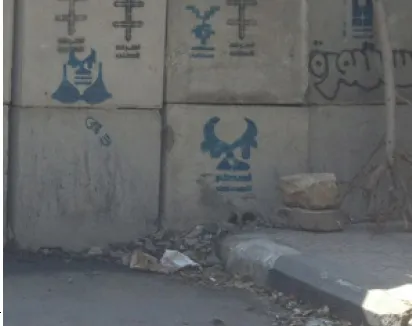
I cannot paint in Cairo. No one wants to hear about the Revolution any more. Supporters of the old regime of the former Egyptian President Hosni Mubarak and those who continue to idolise the military still refer to January 25th as an external intervention by enemies of the state, a cloud that has since passed. To the millions who were in Tahrir Square, however, the Revolution is an aborted dream. The government and its operators have done their best systematically to erase all evidence of our brief moments of freedom. As artists we cannot practise in the street because we channel human emotions, and the general atmosphere in Egypt is one of discomfort.
No one wants to talk about the Revolution. So we stay silent. Outspoken activists who were once symbols of the Revolution are either dead, imprisoned or in exile. So we stay silent. The mouths that once sang and chanted for freedom have been kicked into silence by military boots. So we stay silent. Cairo is an aggressive megalopolis, a city that eats its children. It is loud, dusty and polluted by day, tense and anxious by night.
The city kills the aspirations of its millions of creative souls. Nowadays in Cairo we wake up each day to the news of the death of a promising young talent. Cause of death: unfulfilled dreams.
I stopped painting on the streets of Cairo in 2013. For two years, with the city as my canvas, I had been painting for the Revolution on the walls of Cairo. In November 2011, after documenting the Revolution for nine months as an online archivist, I had had enough. I saw a video of people being shot, their corpses piled up like rubbish on the street. A few months earlier, in January 2011, my artwork ‘A Thousand Times NO’ was uninstalled at the Haus der Kunst in Munich. In that project I traced the chronological evolution of one Arabic letterform – the lam-alif (which means ‘No’ in Arabic) – a thousand times to illustrate the common Arabic expression ‘No, and a thousand times no!’ The different letters were taken from Islamic artefacts and buildings produced under various patrons and Islamic dynasties over the last 1400 years, from Spain to the borders of China. A year earlier the curator at the Haus der Kunst had asked me to contribute a piece of art to the exhibition ‘The Future of Tradition – The Tradition of Future: 100 years after the Exhibition “Masterpieces of Muhammadan Art”’. Her one condition was that I use Arabic script in my work. I was assigned a wall in the gallery and given the freedom to choose any message I wanted. I knew the majority of my audience would not speak Arabic and would not be able to appreciate the beauty and the subtleties of the language. That said, I did not want them to read a translated message, and I certainly didn’t want to show them a set of meaningless letters. So I asked myself, if I had one thing to say to the world at this point in history what would it be? I decided to say ‘No’, a thousand different times.
When the Revolution started I felt helpless and useless. I started following the work of artists on the streets of Cairo. This is when I began thinking of my ‘Nos’ as ammunition. By using them in my work, I drew from 1,400 years of Arab and Islamic visual heritage and connected the historic Arabic script to contemporary issues. Each ‘No’ took its form from history, inspired by calligraphy inscribed on tombstones, walls, mosques and artefacts of the past. My thousand ‘Nos’ became my visual voice for the Revolution.
I added a message to my historic ‘Nos’, making them relevant to today’s world, and finally I felt that I had something to contribute. I sprayed ‘No to Military Rule’; ‘No to Emergency Law’; ‘No to Postponing Trials’; ‘No to Military Trials’, ‘No to Stripping the People’; ‘No to Blinding Heroes’; ‘No to Snipers’; ‘No to Sectarian Divisions’; ‘No to External Agendas’; ‘No to Killing’; ‘No to Burning Books’; ‘No to Violence’; ‘No to Separation Walls’; ‘No to Conspiracy Theories’; ‘No to Bullets’; ‘No to Tear Gas’; ‘No to Aliens’; ‘No to Stealing the Revolution’; ‘No to a New Pharaoh’. No and a thousand times No!
‘No’ was not the only thing I sprayed on the street. In February 2012, 74 young men were killed at a football stadium after a match. They all seemed to be Ultras Ahlawy, fans of the Cairo-based Premier League football club Al Ahly. Rumours circulated that the regime wanted revenge for the Ultras’ participation in the Revolution. When the game finished, the lights were turned off, the doors were locked and the killers were ordered in. Omar Mohsen was a student of The American University in Cairo and was due to graduate that spring. He was one of the young men killed that night. I found a poem by Pablo Neruda scribbled in Arabic in a field hospital in Tahrir. It read: ‘You can crush the flowers but you can’t delay spring.’ I sprayed it on the streets for Omar and the other young men killed by a brutal regime.
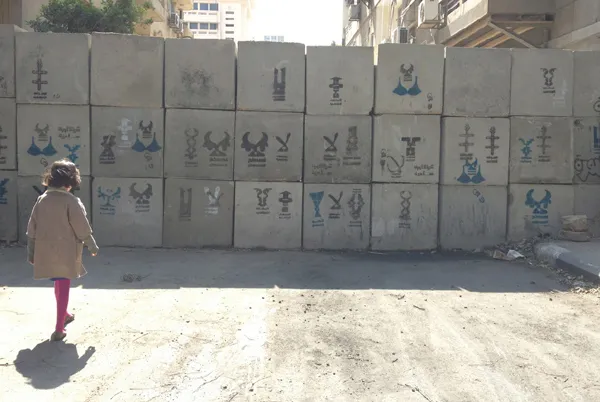

Throughout 2011–12, I regularly took my daughters to the streets of Cairo to show them my work during the Revolution. Everything I was doing was for them, so it made sense that they should be the first to see my work on the street. I showed it to them as if we were at a gallery, explaining what I had painted and why.
For two years a visual dialogue took place on the walls of the city. Something would happen, and dozens of artists would go down to the streets and paint. After a year of being on the street we knew each other’s messages without knowing each other’s faces. The city felt alive. It felt like it had a voice of its own, and was having an ongoing conversation with its citizens. Then everything stopped. Everything was put on hold and a dramatic shift took place. Activists were imprisoned, killed, threatened and silenced. Any voice that opposed was silenced. Any voice that criticised was silenced. We stayed away from the streets. But it felt wrong, like someone stealing your voice after you’ve only just found it.
In 2015, I decided that if the streets of Cairo were no longer accessible to me then I would make the cities of the rest of the world my canvas. When invited to conduct a gallery show in Freiburg I seized the opportunity and took to the streets again. To my surprise, this small German city on the border with Switzerland had twelve walls on which local street artists were permitted to paint. An anti-Islamic wave was sweeping through Europe, and now my cause extended beyond my own city to the world at large. The ‘Nos’ that had been targeted towards specific events in Egypt now became international ‘Nos’, rejecting our current human condition: ‘No to Blood’; ‘No to Extremism’; ‘No to Discrimination’; ‘No to Borders’; ‘No to Killing’; ‘No to Fascism’, ‘No to Racism’; ‘No to Hatred’; ‘No to
Violence’; ‘No to War’; ‘No to Colonisation’; ‘No to Stupidity’; ‘No to Closed Minds’. Like the ‘Nos’ in Cairo, the international ‘Nos’ first sprayed in Freiburg were taken from calligraphic inscriptions on historic buildings across the world: the Karatay Madrasa in Konya, Turkey; buildings and cenotaphs in Cairo; ceramic plates made in Nishapur and Samarkand; a minaret in Afghanistan; and Persian manuscripts now housed at a collection in New York.
Violence’; ‘No to War’; ‘No to Colonisation’; ‘No to Stupidity’; ‘No to Closed Minds’. Like the ‘Nos’ in Cairo, the international ‘Nos’ first sprayed in Freiburg were taken from calligraphic inscriptions on historic buildings across the world: the Karatay Madrasa in Konya, Turkey; buildings and cenotaphs in Cairo; ceramic plates made in Nishapur and Samarkand; a minaret in Afghanistan; and Persian manuscripts now housed at a collection in New York.
We are united by our humanity and our suffering, even those people living in the most developed of countries. When geography was no longer an issue I felt liberated – I used my freedom of movement to help spread my messages. The new series of ‘Nos’ travelled with me to different cities: New Orleans, Istanbul, New York, Tokyo and Vancouver. But there came a point when I found that painting ‘Nos’ was not enough. I had other messages I wanted to share. And it is here
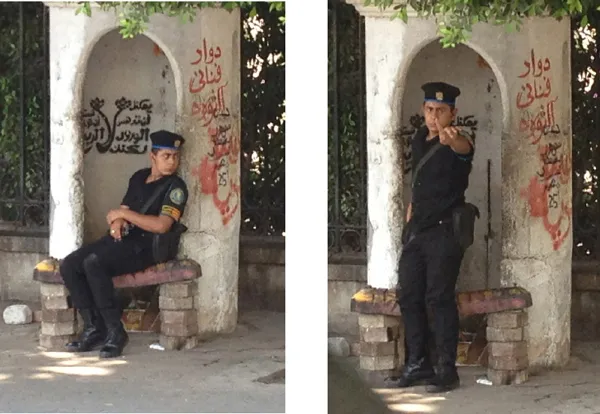
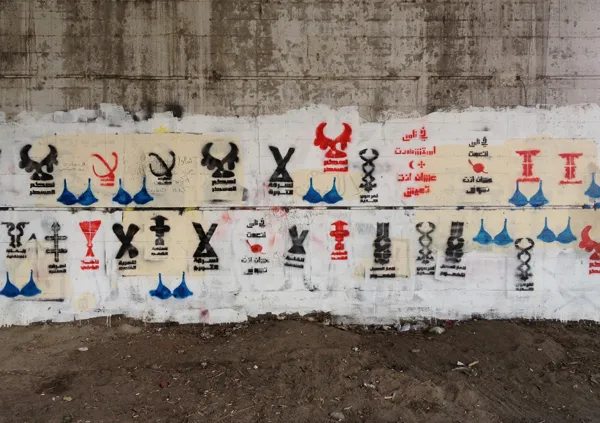

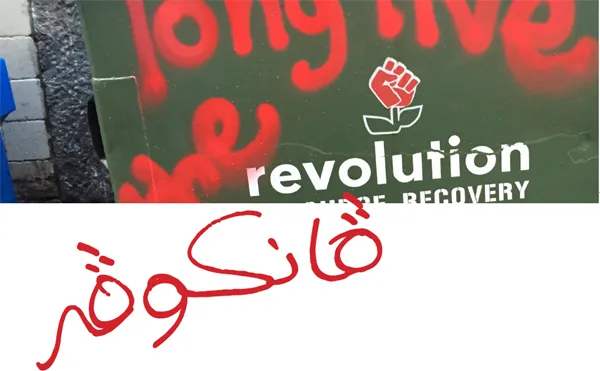
Vancouver:
When meeting
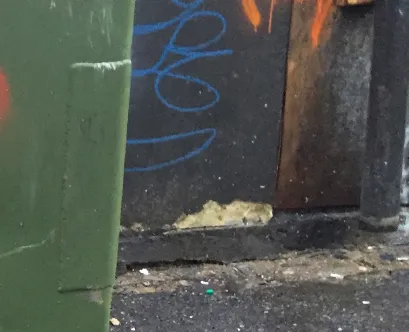
When meeting someone new it was sometimes difficult to answer the simple question: ‘What do you do?’ When I first started taking to the street, it was my habit to answer by saying, jokingly, ‘You mean by day or by night? By day I’m an educator and a scholar, by night I’m a street artist.’ I used invitations to academic conferences as opportunities to paint in different cities. Suddenly I was visiting corners of cities that I never would have set foot in had I not been thinking like a street artist. Marginalised areas, side alleys and slums became my canvases. In Cairo, I usually sprayed between 2 and 4am because...
Table of contents
- Cover Page
- Title
- Copyright
- Table of Contents
- Introduction
- Cairo: You can Crush the Flowers
- Vancouver: Stand and Fight
- New York: Women in Prison
- Madison: No to the Impossible
- Marrakesh: We Love Life
- Istanbul: Size does not Matter
- Tokyo: Two Little Girls
- Cephalonia: People Drowning at Sea
- Beirut: My Suitcase
- Amsterdam: The Story has not Ended
- Stavanger: There will always be Walls
- Paris: Go Paint Arabic in your Country
- Berlin: Not Darwish
- Honolulu: The “Red Indian’s” Penultimate Address to the White Man
- Tunis: Chronic Hope
- Conclusion
- Works Cites
- Thank You’s